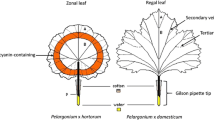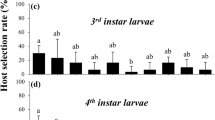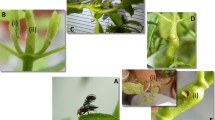Abstract
The possible preference that the leaf-feeding flea-beetle, Alagoasa extrema Jacoby (Coleoptera: Chrysomelidae: Alticinae), might have for different South African naturalized varieties of its host plant, Lantana camara L. (Verbenaceae), was studied under quarantine laboratory conditions. Studies included adult choice trials, larval no-choice trials and multi-generation no-choice trials using five L. camara varieties. Results indicated that A. extrema exhibited a degree of varietal preference under laboratory conditions. Variety 029 White Pink proved to be the most suitable host, although the other four tested varieties were able to support viable populations of A. extrema for three consecutive generations. Should A. extrema be released as biocontrol agent for L. camara in South Africa, all five of the tested varieties should be able to support viable populations of A. extrema in the field.
Similar content being viewed by others
References
Baars, J.-R. and S. Neser, 1999. Past and present initiatives on the biological control of Lantana camara (Verbenaceae) in South Africa. In: T. Olckers and M.P. Hill (eds), Biological Control of Weeds in South Africa (1990–1998). Afr. Ent. Mem. No. 1: 21–33.
S. Broughton (1999) Evaluation of some insect species introduced for the biological control of Lantana camara L. in South-East Queensland, Australia University of Queensland Brisbane, Australia
S. Broughton (2000) ArticleTitleReview and evaluation of lantana biocontrol programs Biol. Contr. 17 272–286 Occurrence Handle10.1006/bcon.1999.0793
C.J. Cilliers (1982) An evaluation of the effects of imported insects on the weed Lantana camara L. in South Africa Rhodes University Grahamstown, South Africa
C.J. Cilliers (1987) ArticleTitleThe evaluation of three insect natural enemies for the biological control of the weed Lantana camara L J. Ent. Soc. S. Afr. 50 15–34
C.J. Cilliers S. Neser (1991) ArticleTitleBiological control of Lantana camara (Verbenaceae) in South Africa Agric. Ecosyst. Environ. 37 57–75
Crawley, M.J., 1989a. Plant life-history and the success of weed biological control projects. In: E.S. Delfosse (ed.), Proceedings of the VII International Symposium of Biological Control of Weeds, Rome, Italy, 1988. Istituto Sperimentale per la Patologia Vegetale, Ministero dell’ Agricoltura e delle Foreste, Rome. pp. 17–26.
M.J. Crawley (1989b) ArticleTitleThe successes and failures of weed biocontrol using insects Biocontrol News Inf. 10 213–223
Day, M.D. and S. Neser, 2000. Factors influencing the biological control of Lantana camara in Australia and South Africa. In: N.R. Spencer (ed.), Proceedings of the X International Symposium on Biological Control of Weeds, July 4–14, 1999, Montana State University, Bozeman, Montana, USA. pp. 897–908.
InstitutionalAuthorNameGenStat for Windows (2000) Release 4.2 EditionNumber5 VSN International Ltd. Oxford, UK
J.L. Graaf (1986) ArticleTitleLantana camara, the plant and some methods for its control S. Afr. Forestry J. March 26–30
Harley, K.L.S., 1973. Biological control of Lantana in Australia. In: A.J. Wapshere (ed), Proceedings of the III International Symposium on Biological Control of Weeds. Montpellier, France. Commonwealth Institute of Biological Control, Farnham Royal, UK. pp. 23–29.
K.L.S. Harley J.D. Kerr R.C. Kassulke (1979) ArticleTitleEffects in S.E. Queensland during 1967–72 of insects introduced to control Lantana camara in Australia Entomophaga 24 65–72
W.H. Haseler (1966) ArticleTitleThe status of insects introduced for the biological control of weeds in Queensland J. Ent. Soc. Queensland 5 1–4
P.B. McEvoy E.M. Coombs (1999) Why things bite back: unintended consequences of biological weed control P.A. Follet J.J. Duan (Eds) Nontarget Effects of Biological Control Kluwer Academic Publishers Boston, Dordrecht, London 167–194
Morris, M.J., A.R. Wood and A. den Breeÿen, 1999. Plant pathogens and biological control of weeds in South Africa: a review of projects and progress during the last decade. In: T. Olckers and M.P Hill (eds), Biological Control of Weeds in South Africa (1990–1998). Afr. Ent. Mem. No. 1: 129–137.
Neser, S. and C.J. Cilliers, 1989. Work towards biological control of Lantana camara: Perspectives. In: E.S. Delfosse (ed.), Proceedings of the VII International Symposium on Biological Control of Weeds. Rome, 1988. Istituto Sperimentale per la Patalogia Vegetale, Ministero dell ‘Agricoltura e delle Foreste, Rome, Italy. pp. 363–369.
R.W. Sanders (2001) ArticleTitleThe genera of Verbenaceae in the Southeastern United States Harvard Papers Bot. 5 303–358
L.J. Scott G.H. Graham M. Hannan-Jones D.K. Yeates (1997) ArticleTitleDNA profiling resolves the limited importance of flower colour in defining varieties of Lantana camara Electrophoresis 18 1560–1563 Occurrence Handle10.1002/elps.1150180912 Occurrence Handle1:CAS:528:DyaK2sXmtF2mtrc%3D Occurrence Handle9378121
Scott, L.J., M.A. Hannan-Jones and G.C. Graham, 2002. Affinities of Lantana camara in the Australia-Pacific Region. In: H. Spafford Jacob, J. Dodd and J.H. Moore (eds), Proceedings of the Thirteenth Australian Weeds Conference. 8–13 September 2002, Perth, Western Australia. pp. 471–474.
Sheppard, A.W., 2002. Prioritising agents based on predicted efficacy: Beyond the lottery approach. In: H. Spafford Jacob and D.T. Briese (eds.), Improving the selection, testing and evaluation of weed biological control agents. Proceedings of the CRC for Australian Weed Management Biological Control of Weeds Symposium and Workshop. Perth, 2002. University of Western Australia, Australia. pp. 11–18.
A.W. Sheppard R. Hill R.A. DeClerck-Floate A. McClay T. Olckers P.C. Quimby SuffixJr. H.G. Zimmermann (2003) ArticleTitleA global review of risk-benefit-cost analysis for the introduction of classical biological control agents against weeds: a crisis in the making? Biocontrol News Inf. 24 IssueID4 91–108
D. Simberloff P. Stiling (1996) ArticleTitleRisks of species introduced for biological control Biol. Conserv. 78 185–192 Occurrence Handle10.1016/0006-3207(96)00027-4
G.W. Snedecor W.G. Cochran (1980) Statistical Methods Iowa State University Press USA
J.J. Spies (1984) ArticleTitleA cytotaxonomic study of Lantana camara (Verbenaceae) from South Africa S. Afr. J. Bot. 3 231–250
R.M.M. Traynier (1979) ArticleTitleLong-term changes in the oviposition behaviour of the cabbage butterfly, Pieris rapae, induced by contact with plants Physiol. Ent. 4 86–96
Urban, A.J. and D.O. Simelane, 1999. Performance of a candidate biocontrol agent, Falconia intermedia (Hemiptera: Miridae), on selected biotypes of Lantana camara (Verbenaceae). In: J.B.J. van Rensburg and J. van den Berg (eds), Proceedings of the Twelfth Entomological Congress. 12–15 July 1999. Potchefstroom, South Africa. p. 120.
F.-H. Wan P. Harris (1997) ArticleTitleUse of risk analysis for screening weed biocontrol agents: Altica carduorum Guer. (Coleoptera: Chrysomelidae) from China as a biocontrol agent of Cirsium arvense (L.) Scop. in North America Biocontrol Sci. Technol. 7 299–308
H.E. Williams (2005) ArticleTitleThe potential impact of the trimorphic flea-beetle, Alagoasa extrema, on a selected weedy variety of Lantana camara BioControl 50 647–655
H.E. Williams C.N. Duckett (2005) ArticleTitleThe trimorphic flea-beetle, Alagoasa extrema, not suitable for biocontrol of Lantana camara in Africa BioControl 50 657–683
Author information
Authors and Affiliations
Corresponding author
Rights and permissions
About this article
Cite this article
Williams, H.E. Preference and Performance of the Polymorphic Flea-beetle, Alagoasa extrema, on Selected, Weedy Lantana camara Varieties. Biocontrol 51, 127–138 (2006). https://doi.org/10.1007/s10526-005-1516-2
Received:
Accepted:
Issue Date:
DOI: https://doi.org/10.1007/s10526-005-1516-2




